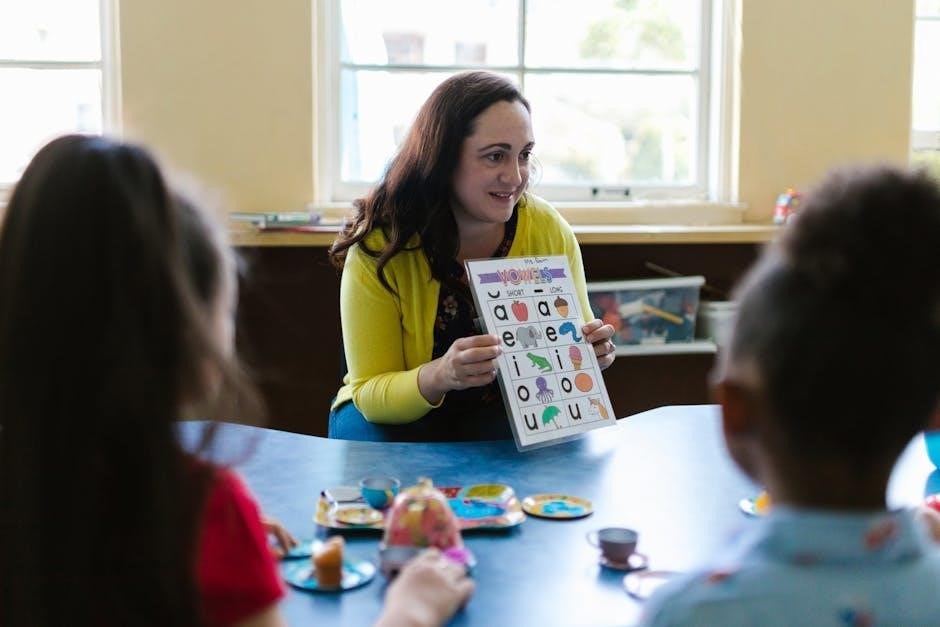
Explicit Instruction in Phonological Awareness
Explicit instruction in phonological awareness involves direct teaching of sound awareness skills‚ such as identifying and manipulating phonemes. It includes structured lessons‚ clear modeling‚ and guided practice to build foundational reading skills systematically.
- Focuses on breaking down complex tasks into manageable steps.
- Emphasizes immediate feedback and opportunities for practice.
- Uses visual and auditory supports to reinforce learning.
- Links new skills to prior knowledge for better retention.
1.1 The Role of Explicit Teaching in Developing Phonemic Awareness
Explicit teaching plays a pivotal role in developing phonemic awareness‚ as it provides learners with clear‚ structured‚ and intentional instruction. This approach ensures that students gain a strong understanding of how sounds function within words‚ which is critical for decoding and reading skills. Explicit teaching involves breaking down complex phonemic awareness tasks‚ such as identifying‚ segmenting‚ and blending sounds‚ into smaller‚ manageable steps. Teachers model these skills directly‚ offering concrete examples and guided practice to reinforce learning. This method is particularly effective because it eliminates ambiguity‚ allowing learners to focus on specific sound manipulations without confusion.
- Provides clear demonstrations and explanations of phonemic awareness skills.
- Includes systematic practice and review to solidify understanding.
- Uses visual and auditory supports to enhance engagement and comprehension.
- Offers immediate feedback to correct misconceptions and build accuracy.
By scaffolding instruction and tailoring activities to learner needs‚ explicit teaching ensures that all students‚ regardless of their starting point‚ can master phonemic awareness effectively.

Systematic Instruction in Phonics
Systematic phonics instruction involves a structured‚ sequential approach to teaching sound-letter relationships‚ building on prior knowledge to develop decoding skills. It emphasizes explicit modeling‚ guided practice‚ and independent application‚ ensuring learners progress steadily in reading proficiency.
- Follows a clear‚ logical sequence of skill development.
- Includes explicit teaching of phoneme-grapheme correspondences.
- Provides ample opportunities for practice and reinforcement.
- Links new skills to previous learning for coherence.
2.1 Linking Phonics Instruction to Prior Learning and Building Skills Progressively
Effective phonics instruction connects new skills to students’ existing knowledge‚ ensuring a logical progression of learning. This approach builds confidence and mastery by revisiting previously taught concepts and integrating them with new ones. Teachers begin with foundational skills like letter-sound recognition before moving to blending and segmenting sounds in words. This systematic progression aligns with how students naturally develop reading abilities. By consistently referencing prior learning‚ educators create a coherent framework that helps learners understand how skills interconnect. For example‚ after teaching single-syllable decoding‚ instructors can introduce more complex patterns like digraphs or vowel teams. This incremental method ensures students are well-prepared to tackle increasingly challenging texts. Regular review and reinforcement of earlier concepts prevent gaps in understanding and solidify long-term retention. Additionally‚ scaffolding techniques‚ such as modeling and guided practice‚ support learners as they apply skills in reading and writing tasks. This progressive‚ interconnected approach fosters fluency and comprehension‚ laying a strong foundation for lifelong literacy.
- Introduces skills in a logical‚ sequential order.
- Revisits and reinforces previously taught concepts.
- Connects new learning to existing knowledge.
- Uses scaffolding to support skill application.
- Ensures cumulative progression toward mastery.

Scaffolding in Language and Literacy Development
Scaffolding provides temporary support to learners‚ helping them build on existing skills. It involves modeling‚ guided practice‚ and feedback‚ enabling students to gradually take ownership of tasks like word decoding and comprehension.
- Offers structured guidance tailored to learners’ needs.
- Encourages active participation and skill mastery.
- Fosters independence through gradual support reduction.
- Enhances understanding and confidence in literacy tasks.
3.1 Strategies for Scaffolding to Support Learners at Different Stages
Scaffolding is a powerful strategy that provides temporary support to learners‚ enabling them to progress toward independence in literacy tasks. Effective scaffolding strategies include modeling‚ guided practice‚ and gradual release of responsibility. Teachers can also use visual aids‚ such as word cards or diagrams‚ to reinforce concepts like phonemic awareness and word decoding. Additionally‚ scaffolding can involve breaking complex tasks into smaller‚ manageable steps‚ allowing learners to focus on one skill at a time. For instance‚ teaching sound blending before expecting learners to decode multisyllabic words ensures a strong foundation. Feedback is another critical component‚ as it helps learners identify errors and refine their understanding. Scaffolding can also be tailored to individual needs‚ such as pre-teaching vocabulary for English language learners or providing extra practice for students who need more reinforcement. By adapting scaffolding strategies to meet the diverse needs of learners‚ educators create an inclusive and supportive learning environment that fosters growth and confidence in language and literacy skills.
- Modeling skills explicitly to demonstrate expectations.
- Providing guided practice with gradual independence;
- Using visual supports to clarify complex concepts.
- Offering constructive feedback to guide improvement.
- Adapting strategies to meet individual learner needs;

Phonemic Awareness as a Foundation for Reading Skills
Phonemic awareness is the ability to identify and manipulate individual sounds in words‚ serving as a critical foundation for reading skills. It enhances decoding‚ spelling‚ and word recognition‚ enabling learners to process text more effectively and accurately.
- Recognizing individual sounds within words.
- Understanding sound segmentation and blending.
- Developing skills to manipulate phonemes.
- Improving decoding and spelling abilities.
4.1 Research-Based Evidence on the Impact of Phonemic Awareness Instruction
Research consistently demonstrates that phonemic awareness instruction significantly improves reading skills‚ particularly in decoding and word recognition. Studies have shown that explicit and systematic teaching of phonemic awareness leads to better reading outcomes for all learners‚ including those with reading difficulties. For example‚ a 2023 study highlighted that students who received structured phonemic awareness lessons exhibited enhanced ability to segment and blend sounds‚ directly correlating with improved reading fluency and comprehension. Additionally‚ longitudinal studies indicate that early intervention in phonemic awareness can prevent reading delays and foster long-term literacy success. The evidence underscores the importance of integrating phonemic awareness into early literacy programs‚ as it provides a strong foundation for future reading development. Furthermore‚ differentiated instruction and scaffolding strategies within phonemic awareness teaching have been shown to support diverse learners effectively‚ ensuring all students benefit from these foundational skills.

Differentiated Instruction for Diverse Learners
Differentiated instruction tailors literacy activities to meet individual student needs‚ ensuring all learners access the curriculum. It involves scaffolding‚ pre-teaching vocabulary‚ and providing background knowledge to support diverse learners effectively and inclusively in their literacy development.
5.1 Tailoring Literacy Activities to Meet Individual Student Needs
Tailoring literacy activities to meet individual student needs ensures that every learner‚ regardless of their abilities or background‚ can engage effectively with the curriculum. This approach involves assessing each student’s strengths‚ challenges‚ and learning preferences to design targeted instruction. Teachers use scaffolding strategies‚ such as modeling‚ guided practice‚ and independent practice‚ to support students at varying stages of development. Additionally‚ incorporating visual‚ auditory‚ and kinesthetic approaches helps cater to diverse learning styles. Differentiated materials‚ including leveled texts and technology tools‚ provide multiple pathways for students to access and master literacy skills. Regular progress monitoring allows educators to adjust instruction dynamically‚ ensuring that no student is left behind. By addressing individual needs‚ teachers create an inclusive and equitable learning environment that fosters growth and confidence in literacy.
- Assessment and feedback are critical for identifying individual needs.
- Scaffolding strategies are used to gradually release responsibility to students.
- Multi-sensory approaches engage learners with varying preferences.
- Differentiated materials ensure accessibility for all learners.
- Progress monitoring informs dynamic adjustments to instruction.